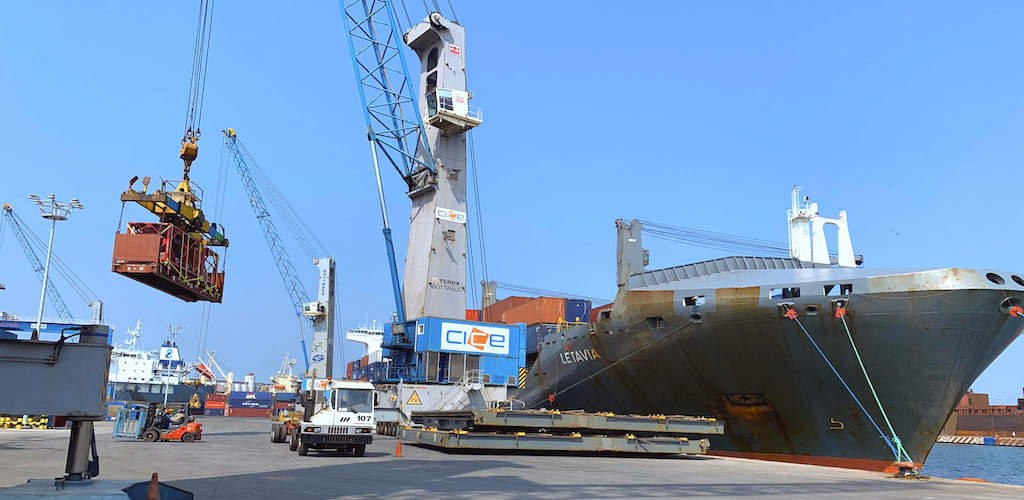Supply Chain Pressures to Continue into 2022

By Malcolm Ramsay
The current boom in multipurpose rates continues this month, but forecasts suggest a decline in 2022 may lead to increased consolidation in the breakbulk sector, as shipping lines race to secure market share and modernize fleets in the aftermath of this year’s extraordinary demand.
The record resurgence in charter rates this year has been welcomed by many in the breakbulk industry, particularly following such a long period of depressed rate, however, the outlook going into 2022 is less auspicious as the prospect of improved container capacity combines with structural improvements to suggest that multipurpose rates may fall.
Simon Heaney, senior manager at Drewry, explains that as of mid-September 2021, the total year-to-date new vessel orders for container ships stands at 3.9 million TEU, meaning that 2021 has already surpassed the previous annual record of 3.3 million TEU set in 2007, with more than three months of this year still remaining. This will likely mean that the unprecedented shift from container to breakbulk shipping will see a major correction in 2022.
While such an adjustment would in normal times be expected, Yorck Niclas Prehm, head of research at maritime consultancy Toepfer Transport predicts that such a swing will add further pressure for many breakbulk operators that are faced with ageing fleets, following a decade of under investment.
“The market is changing rapidly, but still it has to be pointed out that the current rate levels are required to sustain the costs of the inevitable fleet modernisation,” Prehm said.
Timeline extended
As global supply chains shuddered back into operation in 2021, the multiple impacts of the covid pandemic have become ever more apparent as has the urgent need to modernize global shipping fleets but with budgets starting from an exceptionally low baseline any slip in rates will have serious consequences.
For the short-term, Drewry predicts that multipurpose rates will continue to rise, as it forecasts that its monthly Multipurpose Time Charter Index will reach US$10,165 per day in September. A measure of charter rates over a one-year period, the index compares a basket of vessel types and sizes to forecast the market movement over the coming month.
The estimate for September signifies a further 5 percent rise on August rates of US$9,679 per day in August and suggest rates will remain high for longer as the usual summer lull came to an abrupt end.
“This year’s summer lull was particularly short-lived for the shortsea market and by the second half of the month we were already starting to see a pickup in demand, particularly in the Mediterranean and Black Sea ports,” Drewry notes.
Susan Oatway, senior analyst for multipurpose and breakbulk shipping at Drewry, predicts that the current boom will not end “anytime soon” but cautions that record highs cannot be sustained indefinitely.
"This will all stop at some point next year," Oatway predicts noting that the shift back to container vessels could bring a sharp dose of reality for breakbulk operators. Drewry previously estimated that increased container capacity would see rats shift around February next year, in line with the end of Chinese New Year, however Oatway now forecasts that this timeline “will push back a little further” as the scale of the issue in supply chains is unabated.
Hamburg-based Toepfer Transport also predicts sustained highs in multipurpose rates for the moment, forecasting US$14,038 for September. Based on differing data from Drewry’s index, Toepfer’s Multipurpose Shipping Report is published monthly and provides an index based on a 12,500 deadweight-tonne multipurpose /heavy-lift F-Type vessel for a six to 12-month charter period.
Fleet Modernization
As well as the change in cargo from breakbulk to container the record demand this year is also driving a change in operating procedures, leading many shipping lines to face difficult reputational dilemmas.
Prehm of Topefer Transport notes that “While container and wind power related cargoes are further floating the available cargo space, the shippers and forwarders are forced to book their cargoes now fairly in advance instead of spot or prompt, as in the past, to ensure that the transport will take place within the required time frame. There are complaints that some carriers stopped nominating which vessel will perform a voyage or refuse to give a laycan for cargoes except against a premium.”
The rapid acceleration in ‘green’ shipping and digitalisation is also set to add further pressure on operators going into next year, as the need for next-generation ships becomes paramount in key markets and operators struggle to balance the need for investment with a dwindling bottom-line. Arjun Batra, group managing director of Drewry, predicts that industry players looking to buy new vessels at current prices will likely find themselves "overextended."
“Demand for digitalization is rapidly increasing due to the impact of Covid-19, and the need to maintain a competitive order,” Kwang-Myeong Moon, shipping lawyer at Moon & Song said, noting that the earnings recovery will continue for the near-term, with carbon emission regulation emerging as an important topic in the longer term, creating financing issues for shipping lines.
